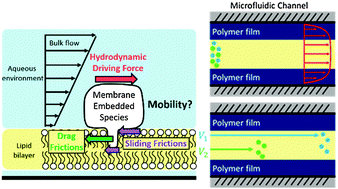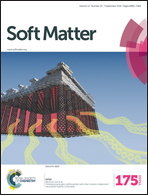Membrane species mobility under in-lipid-membrane forced convection†
Abstract
Processing and managing cell membrane proteins for characterization while maintaining their intact structure is challenging. Hydrodynamic flow has been used to transport membrane species in supported lipid bilayers (SLBs) where the hydrophobic cores of the membrane species can be protected during processing. However, the forced convection mechanism of species embedded in lipid bilayers is still unclear. Developing a controlled SLB platform with a practical model to predict the membrane species mobility in the platform under in-lipid-membrane forced convection is imperative to ensure the practical applicability of SLBs in processing and managing membrane species with various geometrical properties. The mobility of membrane species is affected by the driving force from the aqueous environment in addition to the frictions from the lipid bilayer, in which both lipid leaflets may exhibit different speeds relative to that of the moving species. In this study, we developed a model, based on the applied driving force and the possible frictional resistances that the membrane species encounter, to predict how the mobility under in-lipid-membrane forced convection is influenced by the sizes of the species' hydrophilic portion in the aqueous environment and the hydrophobic portion embedded in the membrane. In addition, we used a microfluidic device for controlling the flow to arrange the lipid membrane and the tested membrane species in the desirable locations in order to obtain a SLB platform which can provide clear mobility responses of the species without disturbance from the species dispersion effect. The model predictions were consistent with the experimental observations, with the sliding friction coefficient between the upper leaflet and the hydrophilic portion of the species as the only regressed parameter. The result suggests that not only the lateral drag frictions from the lipid layers but also the sliding frictions between the species and the lipid layer planes could significantly influence the species mobility. The consistency between the experimental results and the model predictions suggests that our model based on lateral drag and sliding frictions between the species and the lipid leaflets can be used to describe the mobility of half-transmembrane species. We also demonstrated the possibility of how the scope of this model can be broadened to describe the mobility of transmembrane proteins extending through both lipid leaflets.


 Please wait while we load your content...
Please wait while we load your content...